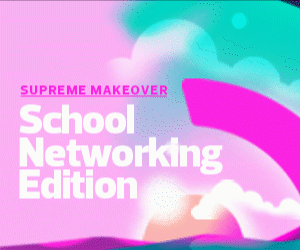Peterson’s story is instructive, but hardly unique. More than two and half years into a global pandemic, school districts continue to struggle with high-speed Wi-Fi and the inequities that result when students and families can’t get consistent and reliable access to essential learning.
As communities adjust to life with COVID-19 and students and teachers return to school full-time, the widening of the so-called “homework gap” — where some learners unwillingly forfeit access to educational content outside of the traditional school day — has IT directors and their teams working overtime to deliver instruction and close learning gaps, especially for at-risk students. Access to reliable broadband remains central to that equation.
How Lynchburg City Schools Uses CBRS to Connect Students at Home
Doing the work is easier said than done — and how you do it often depends on where you live. Whether students hail from rural communities or urban centers, when it comes to digital learning, research suggests the barriers boil down to one of three critical factors: access to hardware or devices, funding levels or network infrastructure.
At Lynchburg City Schools in Virginia, IT Director John Collins says the region benefits from strong broadband coverage.
Unfortunately, in a district with 8,000 students, 63 percent of whom are eligible for free and reduced lunch, that coverage isn’t affordable for many of the community’s neediest families.
“A smartphone internet connection, even if it’s acting as a hotspot, is not enough,” explains Collins, “If you don’t start from the same place, it’s really difficult to climb the ladder at the same rate, or even get on the ladder in some cases. And that’s what access is all about. It’s about giving students what they need so they can grow. In the end, that’s what we’re all trying to do.”
GET THE CHECKLIST: Download a resource for K–12 schools looking to make network upgrades.
Over the years, the district has trotted out a litany of spot fixes to meet its goal of providing adequate high-speed internet access to all students, but those solutions weren’t sustainable.
To extend high-speed coverage to more families and close the homework gap long-term, Collins and the Lynchburg City Schools team recently launched Project WISH (Wireless Service at Home). By tapping into an unused portion of the Citizens Broadband Radio Service (CBRS) spectrum reserved for the U.S. Navy, the district plans to use specially outfitted Wi-Fi towers erected on school and municipal buildings to broadcast dedicated bandwidth to students and families in areas where Wi-Fi access remains weak or limited. The first tower was scheduled to go live in May 2022, with more to follow.
Collins says the program, if successful, will go a long way toward helping the district achieve its goal of 100 percent high-speed broadband access for every student.
Schools Explore Datacasting for Students Who Can't Access Wi-Fi
While two-way, high-speed Wi-Fi remains the gold standard, there are circumstances where that level of access is simply not available or doesn’t make sense for a particular group of learners, such as incarcerated youth or students in hard-to-reach communities.
Ben Smith is assistant director of educational technology for the Lincoln Intermediate Unit, an educational service center serving 25 districts over three Pennsylvania counties.
In addition to several students whose remote geographic locations prohibit access to high-speed Wi-Fi, his team is responsible for delivering educational content to nearly two dozen students in juvenile detention facilities.
As a workaround, the service center is partnering with PBS to transfer files to students over the air using TV broadcast signals.
Called datacasting, the technology works by setting up an antenna connected to a receiver box that acts like a router, where files are posted and stored.
KEEP READING: K–12 leaders speak on equitable education through technology.
“All teachers have to do is drag and drop the files they want to share with students. PDFs and Microsoft Word documents are transferred in minutes. Large, 200-megabit files like videos could be done easily in a couple of hours overnight,” he says.
While datacasting has limitations — it’s essentially an open network that only allows one-way communication — the ability for teachers to post and share files of almost any size means students with limited or no access to two-way Wi-Fi can still access critical learning materials.
Planning Is Key for Schools Depending on Government Funding
As K—12 schools transition from the special brand of chaos that defined the smash-and-grab innovation of the initial months of the pandemic, administrators have begun to shift their focus from early-stage triage to long-haul sustainability. For its part, the Federal Communications Commission, which runs the E-rate program, launched the Emergency Connectivity Fund in 2021. But ECF — a massive $7 billion relief package designed to help schools and libraries deliver remote learning through necessary hardware and services — has largely run out.












